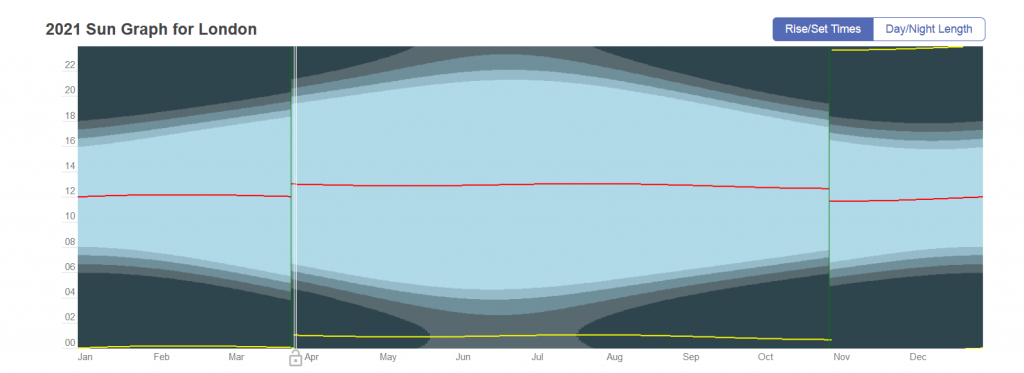******************************************************************
After uttering the testification of faith, (Shahaadah), the most basic ritual act of worship is the performance of the five daily prayers, (Salaah). As with all ritual acts, these prayers are performed in a specific manner demonstrated by the prophet Muhammad (ﷺ).
“Pray as you see me pray…” [Sahih al Bukhari]
The five prayers are spread out during the day and the precise timings have been specified by Allah:
“Verily, the prayer is enjoined on the believers at fixed hours.”
[Qur’an, 4:103]
As the times are based upon the positioning of the sun, our times have been worked out from data from Her Majesty’s Nautical Almanac Office based upon I7.5 degrees (http://astro.ukho.gov.uk).
Fajr – This is the first prayer and its timing begins when the first light appears (beginning of twilight) and ends at sunrise.
Zhuhr – This is the second prayer and its timing begins after the sun starts declining from its zenith and ends at Asr time
Asr – This is the third prayer and there as a difference of opinion regarding its staring time. The majority of scholars hold that it begins at the first Mithl (Mithl1) which occurs when an object is the same size as its shadow. The Hanafi school of thought hold the view that it starts when the shadow is twice its size (Mithl2). We have both timings on our calendar. The end time for Asr is until the sun glows pale before sunset.
Maghrib – This is the fourth prayer and its timing begins when the sun sets and should be prayed as soon as possible although it will be still valid until Esha
Esha – This is the fifth prayer and its timing begins when the redness of twilight (or whiteness for Hanafis) disappears. It should be performed within the first third of the night (or before half of the night for Malikis and Hanbalis).
To clarify the issue, Islamic Centre Edgware had an open seminar on the topic and the slides of the presentation can be found above.
Further FAQs
Why are your prayer times different from other Mosques?
Most of the times are the same on the majority of calendars, but there may be a disparity between the starting times of Fajr and Esha. This is because they are based upon the appearance and disappearance of twilight.
The position of the United Kingdom is globally above a latitude of 44 degrees. This means that during the summer months, between 24 May and 18 July, twilight does not fully disappear which particularly affects the starting time for Fajr, and also the times for Esha. This is a phenomenon known as persistent twilight.
It is for this reason, as Ramadan approached the summer months around 2011 some mosques convened meetings in order to seek solutions for it. The outcome was that London Central Mosque adopted a new timetable called the ‘London Unified Timetable’ which avoided persistent twilight and was based upon calculations. This was followed by most other centres as they based their timetables on London Central Mosque.
However, we have chosen to follow the traditionally, globally accepted values of about 17.5 degrees without any manipulation to the times. One of the main reasons behind our decision was that although there exists the flexibility to calculate the prayer times during persistent twilight, there is no permission to ignore the Shari’ah signs and follow calculations instead. The new ‘London Unified Timetable’ extended the modified times to the months immediately before and after the phenomenon, despite the Shari’ah signs being present, so that the starting times are based upon calculations only and not by the appearance or disappearance of twilight as determined from the sunnah. The reasoning for this can be found on the ICCUK website.
Why does your Fajr time start so early?
The time for Fajr enters when the first light appears. This has been taken from the timings published by Her Majesty’s Nautical Almanac Office based upon 17.5 degrees (http://astro.ukho.gov.uk). During the period of persistent twilight, we have chosen to keep Fajr at the last time that it entered in the period just before it, when the Shari’ah sign for it still existed.
What is meant by Mith1 (Standard) and Mithl2 (Hanafi) for ‘Asr?
The majority of scholars determine the entrance of ‘Asr as the time when an object is the same height as the shadow. The Hanafi based it upon the time that the shadow is twice the size as the object. We have opted to put both times on our calendar to allow people to follow their own school of thought.
How did you calculate the time for Esha?
The time for Esha are also based upon the disappearance of twilight. However, unlike Fajr, there is some flexibility to bring it closer to Maghrib due to hardship. We have used the Um ul Qurra method of keeping Esha 1 hour and 20 minutes after Maghrib.
Are your Islamic dates accurate?
The Islamic dates is determined by the sighting of the new moon. We use the Ummul Qurrah calendar which is not necessarily to be relied upon for acts of worship.

